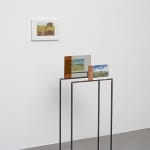Juan Araujo
b. 1971, Caracas, Venezuela
Lives and works in Porto, Portugal
Eu também vivi em Arcadia, 2021
óleo sobre tela; oil on copper
[oil on canvas; oil on copper]
[oil on canvas; oil on copper]
base [plinth]: 91 x 50 x 50 cm | 35 7/8 x 19 3/4 x 19 3/4 in
lâmina cobre I [copper sheet I]: 33,2 x 25 cm | 13 x 9 7/8 in
lâmina cobre I [copper sheet II]: 16,7 x 25 cm | 6 1/4 x 9 7/8 in
pintura base [painting on plinth] 24 x 35 cm | 9 1/2 x 13 3/4 in
pintura na parede [work on the wall]: 24 x 35 cm | 9 1/2 x 13 3/4 in
lâmina cobre I [copper sheet I]: 33,2 x 25 cm | 13 x 9 7/8 in
lâmina cobre I [copper sheet II]: 16,7 x 25 cm | 6 1/4 x 9 7/8 in
pintura base [painting on plinth] 24 x 35 cm | 9 1/2 x 13 3/4 in
pintura na parede [work on the wall]: 24 x 35 cm | 9 1/2 x 13 3/4 in
17749
© artista [the artist]
Further images
-
(View a larger image of thumbnail 1
)

-
(View a larger image of thumbnail 2
)

-
(View a larger image of thumbnail 3
)

-
(View a larger image of thumbnail 4
)

-
(View a larger image of thumbnail 5
)

-
(View a larger image of thumbnail 6
)

-
(View a larger image of thumbnail 7
)

-
(View a larger image of thumbnail 8
)

Eu vivi, também, na Arcádia, célebre frase de um poema bucólico das “Éclogas" (c. 39–38) de Virgílio, é o título da nova série de pinturas do artista venezuelano Juan Araujo especialmente concebidas para a exposição coletiva O Canto do Bode na Casa da Cultura da Comporta.
As pinturas, assentes num plinto desenhado pelo arquiteto Manuel Aires Mateus, mostram a reprodução de uma imagem da Casa em Monsaraz (2007-2009) – projeto do atelier Aires Mateus que reinventa a poética da gruta e da noção de arquitetura como abrigo/refúgio –, em diálogo com um dos testemunhos mais imponentes da presença do megalitismo funerário em Portugal, a Anta de Melriça em Castelo de Vide. Ao fundo, na parede, uma pintura feita a partir de um postal antigo na qual se vê um pastor alentejano sentado em profunda melancolia, remete-nos para a ideia de fantasia pastoral, de uma utopia perdida e de um mundo prestes a desaparecer. Esta nova série de pinturas, traz uma das temáticas mais debatidas pela cultura e história da arte ocidentais – refira-se, por exemplo, os pintores Nicolas Poussin (1594-1665) e Claude Lorrain (1600-82) –, e que se relaciona com a evolução da construção mental da Arcádia ao longo dos tempos e a sua relação dicotómica com a ideia de lugar/sítio e arquitetura. Existe arquitetura sem lugar? É possível existir um lugar utópico sem intervenção material ou mental? Terá a noção de ruína na modernidade perpassado um sentido de destruição, perda, abandono, memória e se convertido numa projeção imaginativa do passado?
[I also lived in Arcadia, a famous phrase from a bucolic poem from Virgílio's “Eclogas” (c. 39–38), is the title of the new series of paintings by Venezuelan artist Juan Araujo specially conceived for the group exhibition O Canto do Goat at Comporta's House of Culture.
The paintings, based on a plinth designed by architect Manuel Aires Mateus, show the reproduction of an image of the House in Monsaraz (2007-2009) – a project by the Aires Mateus studio that reinvents the poetics of the cave and the notion of architecture as a shelter/refuge – , in dialogue with one of the most imposing testimonies of the presence of funerary megalithism in Portugal, the Melriça Tapir in Castelo de Vide. In the background, on the wall, a painting made from an old postcard in which an Alentejo shepherd sits in a deep melancholy, reminds us of the idea of pastoral fantasy, a lost utopia and a world about to disappear. This new series of paintings brings one of the most debated themes in Western culture and art history – refer, for example, to the painters Nicolas Poussin (1594-1665) and Claude Lorrain (1600-82) – and which is related with the evolution of Arcadia's mental construction over time and its dichotomous relationship with the idea of place/site and architecture. Is there architecture without a place? Is it possible for a utopian place to exist without material or mental intervention? Has the notion of ruin in modernity permeated a sense of destruction, loss, abandonment, memory and converted into an imaginative projection of the past?]
1
from
12







